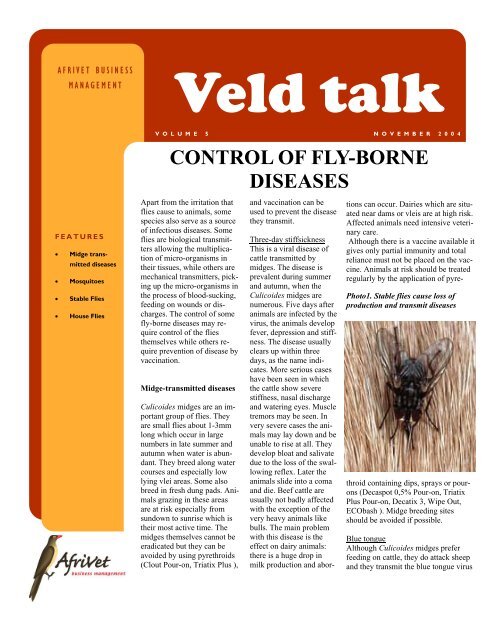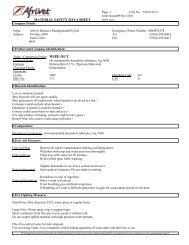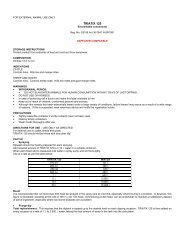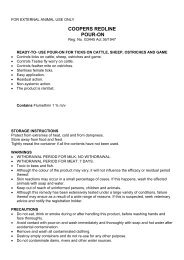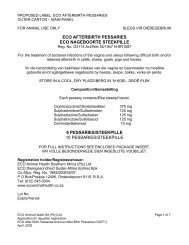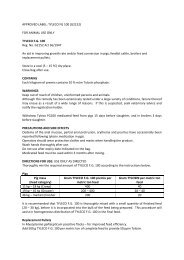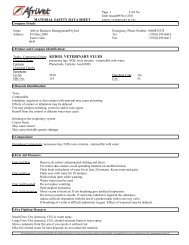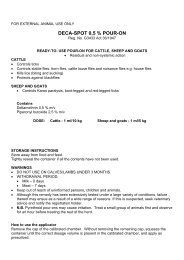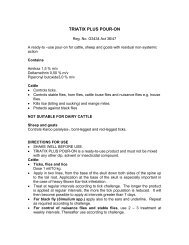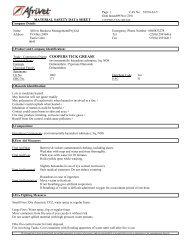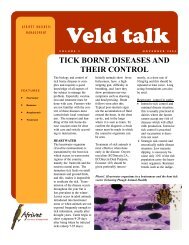Control of fly borne diseases.pdf - Afrivet
Control of fly borne diseases.pdf - Afrivet
Control of fly borne diseases.pdf - Afrivet
Create successful ePaper yourself
Turn your PDF publications into a flip-book with our unique Google optimized e-Paper software.
AFRIVET BUSINESS<br />
MANAGEMENT<br />
Veld talk<br />
FEATURES<br />
• Midge transmitted<br />
<strong>diseases</strong><br />
• Mosquitoes<br />
• Stable Flies<br />
• House Flies<br />
V O L U M E 5<br />
CONTROL OF FLY-BORNE<br />
DISEASES<br />
Apart from the irritation that<br />
flies cause to animals, some<br />
species also serve as a source<br />
<strong>of</strong> infectious <strong>diseases</strong>. Some<br />
flies are biological transmitters<br />
allowing the multiplication<br />
<strong>of</strong> micro-organisms in<br />
their tissues, while others are<br />
mechanical transmitters, picking<br />
up the micro-organisms in<br />
the process <strong>of</strong> blood-sucking,<br />
feeding on wounds or discharges.<br />
The control <strong>of</strong> some<br />
<strong>fly</strong>-<strong>borne</strong> <strong>diseases</strong> may require<br />
control <strong>of</strong> the flies<br />
themselves while others require<br />
prevention <strong>of</strong> disease by<br />
vaccination.<br />
Midge-transmitted <strong>diseases</strong><br />
Culicoides midges are an important<br />
group <strong>of</strong> flies. They<br />
are small flies about 1-3mm<br />
long which occur in large<br />
numbers in late summer and<br />
autumn when water is abundant.<br />
They breed along water<br />
courses and especially low<br />
lying vlei areas. Some also<br />
breed in fresh dung pads. Animals<br />
grazing in these areas<br />
are at risk especially from<br />
sundown to sunrise which is<br />
their most active time. The<br />
midges themselves cannot be<br />
eradicated but they can be<br />
avoided by using pyrethroids<br />
(Clout Pour-on, Triatix Plus ),<br />
and vaccination can be<br />
used to prevent the disease<br />
they transmit.<br />
Three-day stiffsickness<br />
This is a viral disease <strong>of</strong><br />
cattle transmitted by<br />
midges. The disease is<br />
prevalent during summer<br />
and autumn, when the<br />
Culicoides midges are<br />
numerous. Five days after<br />
animals are infected by the<br />
virus, the animals develop<br />
fever, depression and stiffness.<br />
The disease usually<br />
clears up within three<br />
days, as the name indicates.<br />
More serious cases<br />
have been seen in which<br />
the cattle show severe<br />
stiffness, nasal discharge<br />
and watering eyes. Muscle<br />
tremors may be seen. In<br />
very severe cases the animals<br />
may lay down and be<br />
unable to rise at all. They<br />
develop bloat and salivate<br />
due to the loss <strong>of</strong> the swallowing<br />
reflex. Later the<br />
animals slide into a coma<br />
and die. Beef cattle are<br />
usually not badly affected<br />
with the exception <strong>of</strong> the<br />
very heavy animals like<br />
bulls. The main problem<br />
with this disease is the<br />
effect on dairy animals:<br />
there is a huge drop in<br />
milk production and abor-<br />
N O V E M B E R 2 0 0 4<br />
Photo1. Stable flies cause loss <strong>of</strong><br />
production and transmit <strong>diseases</strong><br />
tions can occur. Dairies which are situated<br />
near dams or vleis are at high risk.<br />
Affected animals need intensive veterinary<br />
care.<br />
Although there is a vaccine available it<br />
gives only partial immunity and total<br />
reliance must not be placed on the vaccine.<br />
Animals at risk should be treated<br />
regularly by the application <strong>of</strong> pyrethroid<br />
containing dips, sprays or pourons<br />
(Decaspot 0,5% Pour-on, Triatix<br />
Plus Pour-on, Decatix 3, Wipe Out,<br />
ECObash ). Midge breeding sites<br />
should be avoided if possible.<br />
Blue tongue<br />
Although Culicoides midges prefer<br />
feeding on cattle, they do attack sheep<br />
and they transmit the blue tongue virus
PAGE 2<br />
Lumpy skin<br />
disease can be<br />
catastrophic in<br />
dairies as milk<br />
production can<br />
fall dramatically<br />
and cows can<br />
develop mastitis<br />
due to lesions<br />
occurring on the<br />
udders.<br />
in the process. Sheep grazed<br />
in low-lying vlei areas are<br />
especially at risk and particularly<br />
at the time <strong>of</strong> their<br />
greatest activity, from sundown<br />
to sunrise. Blue<br />
tongue is an exceptionally<br />
important disease <strong>of</strong> sheep<br />
because <strong>of</strong> the damage it<br />
can do to the flock; up to<br />
30% <strong>of</strong> lambs may die and<br />
those that survive may have<br />
lasting muscle damage,<br />
suffer a break in the wool,<br />
and lose weight. Although<br />
there is a variation in susceptibility<br />
among sheep<br />
breeds and even individuals,<br />
the typical symptoms <strong>of</strong><br />
blue tongue are high fever,<br />
inflammation <strong>of</strong> nose and<br />
lips, which later progresses<br />
to erosions. The head and<br />
tongue may show severe<br />
swelling. In more severe<br />
cases the feet will be affected<br />
causing lameness and<br />
animals may walk on their<br />
knees due to the severity <strong>of</strong><br />
the pain.<br />
Vaccination is the only<br />
practical method <strong>of</strong> control<br />
although it is labour intensive,<br />
because the vaccine<br />
contains 21 different strains<br />
divided into 3 separate vaccines.<br />
These three have to<br />
be given separately at three<br />
week intervals. Sufficient<br />
time must be allowed for<br />
this vaccination programme<br />
before the peak blue tongue<br />
season in late summer. It<br />
must also be <strong>borne</strong> in mind<br />
that pregnant ewes cannot<br />
be vaccinated in the first<br />
half <strong>of</strong> pregnancy so vaccination<br />
must be carefully<br />
planned to fit in with management<br />
issues. Midge attacks<br />
on sheep can be reduced<br />
by avoiding vlei areas,<br />
and also by grazing<br />
cattle with sheep.<br />
Mosquitoes<br />
Certain mosquito species<br />
have a preference for livestock<br />
and these breed in<br />
their millions during very<br />
heavy summer rain seasons.<br />
These conditions are ideal<br />
for the transmission <strong>of</strong> Rift<br />
Valley Fever virus (RVF).<br />
RVF is a disease <strong>of</strong> cattle,<br />
sheep and goats which<br />
causes abortion storms <strong>of</strong><br />
40-100 %, and acute deaths<br />
<strong>of</strong> lambs and kids (30%).<br />
Calves may also be affected<br />
but to a lesser extent. The<br />
last outbreaks were seen in<br />
SA during the 1970s although<br />
the virus is known<br />
to be present. It would appear<br />
that outbreaks have<br />
been prevented due to summer<br />
rain falling later in the<br />
season, preventing the multiplication<br />
<strong>of</strong> the specific<br />
mosquito species. However,<br />
vaccination is easy and economical<br />
and should be done<br />
before the summer season.<br />
Stable flies<br />
Stable flies (Stomoxys calcitrans)<br />
are biting, blood-sucking<br />
flies which cause problems in<br />
intensive systems such as dairies,<br />
pig units and poultry<br />
houses. They breed in compost<br />
heaps and manure. The flies<br />
transmit important <strong>diseases</strong> but<br />
also cause severe irritation and<br />
lead to significantly lowered<br />
production <strong>of</strong> milk and meat.<br />
Lumpy Skin Disease is a viral<br />
disease transmitted by stable<br />
flies, chie<strong>fly</strong> in the summer<br />
months. Before the development<br />
<strong>of</strong> the characteristic<br />
lumps, the animals develop a<br />
fever and are depressed. The<br />
skin lesions appear 14 days<br />
after the original infection and<br />
these can be limited to focal<br />
areas or can be widespread all<br />
over the body. Initially the lesions<br />
are slight lumps under the<br />
skin but later the skin may fall<br />
out and leave deep open<br />
wounds. More severe and <strong>of</strong>ten<br />
fatal cases are <strong>of</strong>ten seen in<br />
young animals, affecting the<br />
internal organs such as the trachea.<br />
In dairies the disease can be<br />
catastrophic as milk production<br />
falls dramatically and cows<br />
Photo 2. Blue tongue is a serious disease which can be prevented<br />
with proper vaccination programs<br />
VELD TALK
VOLUME 5<br />
PAGE 3<br />
develop mastitis due to lesions occurring<br />
on the udders. The control <strong>of</strong> LSD is<br />
simply vaccination <strong>of</strong> animals at weaning<br />
and thereafter annual vaccination <strong>of</strong><br />
all animals. Usually calves are protected<br />
by colostral immunity but there is a<br />
small percentage <strong>of</strong> animals that are<br />
genetically unable to develop antibodies<br />
although they themselves are immune to<br />
the disease. Such a cow may not be able<br />
to protect her calf, and in herds where<br />
this is a problem calves should be vaccinated<br />
earlier than the recommended 3-6<br />
months, repeating vaccination again<br />
some months later. Note that LSD can<br />
be spread from one area to another by<br />
the transport <strong>of</strong> infected animals.<br />
LSD can be confused with Allerton virus<br />
infection which is also transmitted<br />
by stable flies, but this is a mild condition<br />
which clears up uneventfully.<br />
Photo 3. Lumpy skin is a serious virus disease which is transmitted by stable flies.<br />
It is easily prevented with annual vaccination. (Onderstepoort Veterinary Institute)<br />
Anaplasmosis<br />
Anaplasmosis is chie<strong>fly</strong> a tick-<strong>borne</strong><br />
disease but the organism can also transmitted<br />
by stable flies especially in dairies<br />
and feedlots. An outbreak <strong>of</strong> anaplasmosis<br />
begins by tick infestation but can<br />
spread rapidly by stable flies. Fly control<br />
is therefore very important.<br />
Besnoitia or elephant skin disease<br />
Elephant skin disease is a protozoal disease<br />
transmitted by stable flies. The disease<br />
is confined to Limpopo Province<br />
where the origin <strong>of</strong> the parasite was in<br />
wildebeest. The parasite causes a thickening<br />
<strong>of</strong> the skin, which leads to fold formation.<br />
The disease can cause sterility in<br />
bulls if the scrotum is affected. The condition<br />
can be prevented by the control <strong>of</strong><br />
Photo 4. Elephant skin disease occurs in Limpopo province and is easily prevented<br />
using pyrethroid applications. (Onderstepoort Veterinary Institute)<br />
stable flies. Stable <strong>fly</strong> control under extensive<br />
conditions is achieved by the application<br />
<strong>of</strong> pyrethroid dips/ pour-ons<br />
(Decaspot 0,5% Pour-on, Triatix Plus<br />
Pour-on, Decatix 3, Wipe Out, ECObash<br />
).<br />
House flies and their relatives<br />
House flies (Musca domestica) are nonbiting<br />
flies which breed in manure and<br />
other organic material like kitchen waste.<br />
They occur in large numbers around<br />
houses and farmyards because they usually<br />
have suitable breeding sites. House<br />
flies cause annoyance which leads to<br />
milk reduction and weight loss. They are<br />
mechanical transmitters <strong>of</strong> bacteria and<br />
play a role in the spread <strong>of</strong> mastitis and<br />
eye infections.<br />
Face flies are small flies which follow<br />
cattle on the veld. The adult flies feed on<br />
wounds and eye discharges.<br />
Eye infections<br />
A variety <strong>of</strong> micro-organisms cause eye<br />
infections in sheep and cattle for example<br />
Moraxella, Chlamydia and Mycoplasma<br />
species. Infection occurs in summer<br />
months and is predisposed by high inten-
VOLUME 5<br />
PAGE 4<br />
sity UV radiation and low levels <strong>of</strong><br />
vitamin A. Infection is spread rapidly<br />
by flies when animals are kraaled together.<br />
Infected animals must be separated<br />
and treated with the administration<br />
<strong>of</strong> tetracyclines. The control <strong>of</strong><br />
flies will limit the spread <strong>of</strong> these infections.<br />
“False bruising”<br />
The condition <strong>of</strong> cattle referred to as<br />
“false bruising” is actually an infestation<br />
with the roundworm Parafilaria<br />
bovicola. It is spread by the face flies<br />
Musca lusoria and M. xanthomelas.<br />
The flies lay their eggs in the manure <strong>of</strong><br />
cattle and feed on wounds and the area<br />
around the eyes. The Parafilaria worms<br />
develop in the body <strong>of</strong> the face flies and<br />
burst out <strong>of</strong> their mouthparts when the<br />
flies are feeding. The tiny worms enter the<br />
eyes <strong>of</strong> cattle and migrate until they enter<br />
the bloodstream <strong>of</strong> the cow. The females<br />
settle under the skin, laying eggs and causing<br />
small wounds or “bleeding points”.<br />
This attracts the face flies which pick up<br />
the worm eggs and thus complete the<br />
worm’s life cycle.<br />
“False bruising” reduces the value <strong>of</strong> the<br />
carcass after slaughter because the affected<br />
areas have to be trimmed away. Infestations<br />
are easily treated with macrocyclic<br />
lactones (ECOmectin 1% injectable,<br />
ECOmectin Cattle Pour-on). Prevention<br />
using pyrethroid-containing dips and<br />
sprays is very effective (Decaspot 0,5%<br />
Pour-on, Triatix Plus Pour-on, Decatix 3,<br />
Wipe Out, ECObash ).<br />
.<br />
Dr Pamela Hunter<br />
Photo 5. The typical “bleeding spots” caused by infestation with the worm Parafilaria bovicola.<br />
The worm is transmitted by face flies and causes the “false bruising” syndrome.


